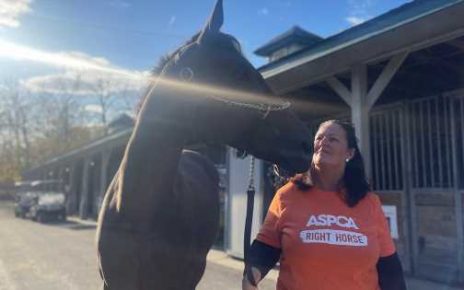
As Director of Animal Welfare at the ASPCA Adoption Center in Manhattan, Ruth Allen oversees the care of animals during their stay.
“If everything’s going great, I don’t hear about it,” Ruth explains. “But if there are dogs who won’t walk on a leash or cats with issues, I get pulled in.”
So, when staff reported a five-year-old Border Collie-mix named Solo who hadn’t eaten in two days, Ruth was alerted.
“He was very stressed and would not make eye contact,” Ruth recalls. “I started spending time with him, hand-feeding him chicken and rice. After a couple of days, he lightened up. I said to myself, ‘there is an awesome dog in there somewhere.’”
Ruth’s time with Solo would awaken something inside her as well—a strong desire to take him in. And on August 14, Ruth adopted Solo.
“I’d been thinking about adopting a dog for a long time, but for different reasons, I never did,” she says.

First Steps
On the day of the adoption, ASPCA staff helped load Solo into Ruth’s car, and during a torrential downpour, she drove the 50 miles to her home in New Jersey.
That’s when Ruth discovered Solo has extreme anxiety related to thunderstorms.
“I was totally unprepared. Solo cowered on the floor in front of the passenger seat,” Ruth explains. “When we got home, the sun came up, and he wallowed in the grass in my backyard. Then he was on my lap for most of the night and slept for 24 hours. He was exhausted.”
Solo was originally transported to the ASPCA from a shelter in Tennessee when he was a puppy. He was adopted and returned twice, most recently in July. At one point there were two adoption holds on him, but they both fell through. Ruth took that as a sign that he was meant for her. “I felt like he was one in a million,” says Ruth.
While Ruth spends time building up Solo’s confidence, Solo does the same for Ruth.

Helping Each Other
“I’m a city girl, but I live in the country,” she explains. “I had never ventured down my block, let alone to lakes and woods, which are all within walking distance. But now we visit those places. We are out and about every day, and he makes me push myself beyond my comfort zone.
“I see now how dogs open doors,” Ruth adds. “Solo provides me with mental support. I’ve lost weight. I love spending time with him. I need him as much as he needs me.”
As the weeks passed, Ruth discovered Solo was not just anxious during thunderstorms—he had multiple triggers. As one example, when Ruth’s furnace first clicked on, Solo paced and scratched at the floor.
Ruth installed video cameras to watch how Solo’s anxiety and isolation frustration manifested itself in destructive ways.
“I’ve worked in animal welfare for years, and I now have a dog with behavior issues,” Ruth says with amusement. “My personal life is bleeding into my professional life.”
Before Ruth came to the ASPCA 10 years ago, she worked as a supervisor at Animal Care Centers of NYC (ACC) and a manager at Bide-a-wee. But even with all that experience, she knew that—as a first-time pet parent —she needed help.
To this day, Ruth shares Solo’s special moments on social media and asks for advice and support from colleagues and other dog owners. She also works closely with ASPCA behavior experts and reads books about dog behavior.
“Ruth dove into all of our resources to learn how to manage Solo’s anxiety,” says Rachel Maso, Behavior Specialist at the ASPCA’s Adoption Center. “We worked together on relaxation techniques that she took home and implemented, and we came up with enrichment options to help Solo handle his stress when he was alone.”
To counter-condition Solo when the furnace clicks on, Ruth gives him treats.
“At first, he wouldn’t eat them. He would just pace and look worried, and at night he would wake up and tear through the garbage” she explains. “But one morning the heat came on and he didn’t even flinch. He didn’t get up, he didn’t start pacing, he didn’t do anything!
“One anxious problem solved, 100 more to go!” Ruth posted to Facebook.

Aiming for Progress, not Perfection
Progress has been slow, but each step forward is celebrated.
Ruth leaves her clothing on Solo’s bedding so her scent is always near. She also discovered a nearby dog park where Solo can play off-leash with other dogs. She makes sure he gets vigorous exercise, going outside regularly where he can dig holes and hide bones.
As a form of stress relief, Solo sometimes shreds cardboard, though this habit is waning.
“I’m not crazy about it, but I recognize it’s an outlet for his angst,” Ruth says. “I don’t react to the mess. I wait until we go for a walk and he is fully exercised, and then I clean up. If I’m relaxed, then he’s less likely to be anxious. It’s kind of a game.”
One day on video she noticed Solo sleeping for an extended period while she was away.
“He did shred a few boxes, but he wasn’t pacing and looking for me,” she explains. “I consider that progress. For anyone dealing with animals with anxiety issues, it’s exciting to see progress.”
Though Solo’s progress is slow, Ruth looks forward to the days, weeks and years ahead with her beloved dog. “He may not be perfect, but neither am I. There are good days and bad days, and we’re figuring it out,” Ruth says. “But one day, we’re going to look back at this and just laugh.”

Source: Read Full Article



